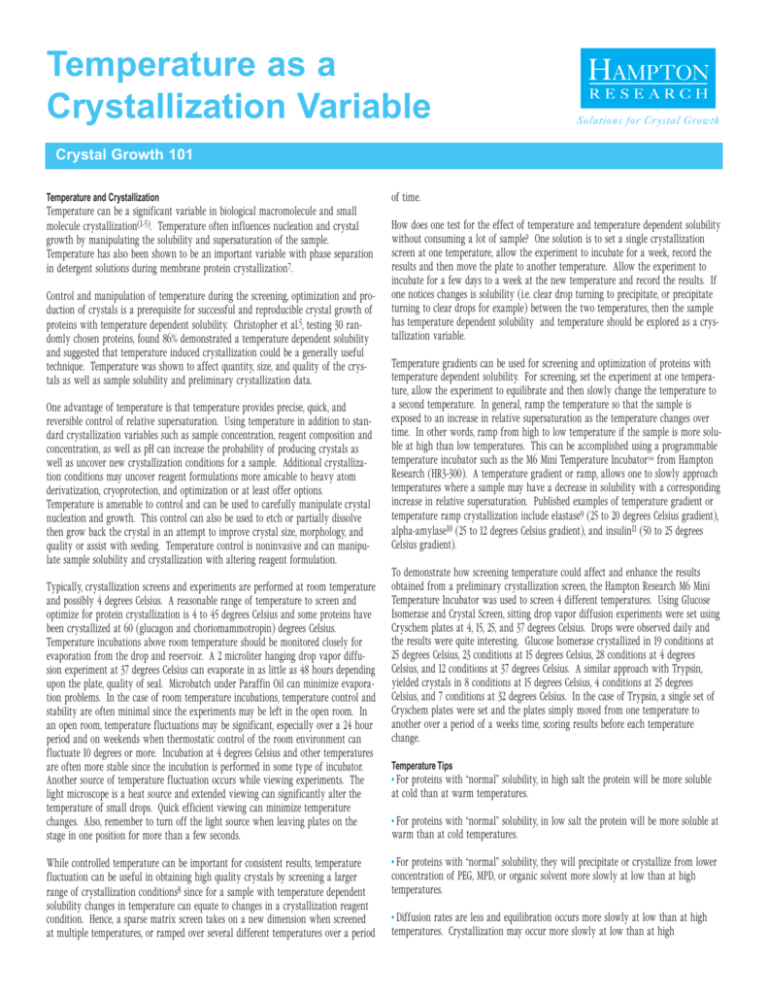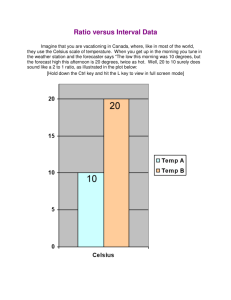
Temperature as a
Crystallization Variable
Solutions for Cr ystal Growth
Crystal Growth 101
Temperature and Crystallization
Temperature can be a significant variable in biological macromolecule and small
molecule crystallization(1-5). Temperature often influences nucleation and crystal
growth by manipulating the solubility and supersaturation of the sample.
Temperature has also been shown to be an important variable with phase separation
in detergent solutions during membrane protein crystallization7.
Control and manipulation of temperature during the screening, optimization and production of crystals is a prerequisite for successful and reproducible crystal growth of
proteins with temperature dependent solubility. Christopher et al.5, testing 30 randomly chosen proteins, found 86% demonstrated a temperature dependent solubility
and suggested that temperature induced crystallization could be a generally useful
technique. Temperature was shown to affect quantity, size, and quality of the crystals as well as sample solubility and preliminary crystallization data.
One advantage of temperature is that temperature provides precise, quick, and
reversible control of relative supersaturation. Using temperature in addition to standard crystallization variables such as sample concentration, reagent composition and
concentration, as well as pH can increase the probability of producing crystals as
well as uncover new crystallization conditions for a sample. Additional crystallization conditions may uncover reagent formulations more amicable to heavy atom
derivatization, cryoprotection, and optimization or at least offer options.
Temperature is amenable to control and can be used to carefully manipulate crystal
nucleation and growth. This control can also be used to etch or partially dissolve
then grow back the crystal in an attempt to improve crystal size, morphology, and
quality or assist with seeding. Temperature control is noninvasive and can manipulate sample solubility and crystallization with altering reagent formulation.
Typically, crystallization screens and experiments are performed at room temperature
and possibly 4 degrees Celsius. A reasonable range of temperature to screen and
optimize for protein crystallization is 4 to 45 degrees Celsius and some proteins have
been crystallized at 60 (glucagon and choriomammotropin) degrees Celsius.
Temperature incubations above room temperature should be monitored closely for
evaporation from the drop and reservoir. A 2 microliter hanging drop vapor diffusion experiment at 37 degrees Celsius can evaporate in as little as 48 hours depending
upon the plate, quality of seal. Microbatch under Paraffin Oil can minimize evaporation problems. In the case of room temperature incubations, temperature control and
stability are often minimal since the experiments may be left in the open room. In
an open room, temperature fluctuations may be significant, especially over a 24 hour
period and on weekends when thermostatic control of the room environment can
fluctuate 10 degrees or more. Incubation at 4 degrees Celsius and other temperatures
are often more stable since the incubation is performed in some type of incubator.
Another source of temperature fluctuation occurs while viewing experiments. The
light microscope is a heat source and extended viewing can significantly alter the
temperature of small drops. Quick efficient viewing can minimize temperature
changes. Also, remember to turn off the light source when leaving plates on the
stage in one position for more than a few seconds.
While controlled temperature can be important for consistent results, temperature
fluctuation can be useful in obtaining high quality crystals by screening a larger
range of crystallization conditions8 since for a sample with temperature dependent
solubility changes in temperature can equate to changes in a crystallization reagent
condition. Hence, a sparse matrix screen takes on a new dimension when screened
at multiple temperatures, or ramped over several different temperatures over a period
of time.
How does one test for the effect of temperature and temperature dependent solubility
without consuming a lot of sample? One solution is to set a single crystallization
screen at one temperature, allow the experiment to incubate for a week, record the
results and then move the plate to another temperature. Allow the experiment to
incubate for a few days to a week at the new temperature and record the results. If
one notices changes is solubility (i.e. clear drop turning to precipitate, or precipitate
turning to clear drops for example) between the two temperatures, then the sample
has temperature dependent solubility and temperature should be explored as a crystallization variable.
Temperature gradients can be used for screening and optimization of proteins with
temperature dependent solubility. For screening, set the experiment at one temperature, allow the experiment to equilibrate and then slowly change the temperature to
a second temperature. In general, ramp the temperature so that the sample is
exposed to an increase in relative supersaturation as the temperature changes over
time. In other words, ramp from high to low temperature if the sample is more soluble at high than low temperatures. This can be accomplished using a programmable
temperature incubator such as the M6 Mini Temperature Incubator™ from Hampton
Research (HR3-300). A temperature gradient or ramp, allows one to slowly approach
temperatures where a sample may have a decrease in solubility with a corresponding
increase in relative supersaturation. Published examples of temperature gradient or
temperature ramp crystallization include elastase9 (25 to 20 degrees Celsius gradient),
alpha-amylase10 (25 to 12 degrees Celsius gradient), and insulin11 (50 to 25 degrees
Celsius gradient).
To demonstrate how screening temperature could affect and enhance the results
obtained from a preliminary crystallization screen, the Hampton Research M6 Mini
Temperature Incubator was used to screen 4 different temperatures. Using Glucose
Isomerase and Crystal Screen, sitting drop vapor diffusion experiments were set using
Cryschem plates at 4, 15, 25, and 37 degrees Celsius. Drops were observed daily and
the results were quite interesting. Glucose Isomerase crystallized in 19 conditions at
25 degrees Celsius, 23 conditions at 15 degrees Celsius, 28 conditions at 4 degrees
Celsius, and 12 conditions at 37 degrees Celsius. A similar approach with Trypsin,
yielded crystals in 8 conditions at 15 degrees Celsius, 4 conditions at 25 degrees
Celsius, and 7 conditions at 32 degrees Celsius. In the case of Trypsin, a single set of
Cryschem plates were set and the plates simply moved from one temperature to
another over a period of a weeks time, scoring results before each temperature
change.
Temperature Tips
• For proteins with “normal” solubility, in high salt the protein will be more soluble
at cold than at warm temperatures.
• For proteins with “normal” solubility, in low salt the protein will be more soluble at
warm than at cold temperatures.
• For proteins with “normal” solubility, they will precipitate or crystallize from lower
concentration of PEG, MPD, or organic solvent more slowly at low than at high
temperatures.
• Diffusion rates are less and equilibration occurs more slowly at low than at high
temperatures. Crystallization may occur more slowly at low than at high
Temperature as a
Crystallization Variable
Crystal Growth 101
Solutions for Cr ystal Growth
2
temperatures.
termination.
• Temperature effects can be more pronounced at low ionic strength reagent
conditions.
• Temperature can be a habit modifier and change the crystal lattice. For example, at
temperatures below 25 degrees Celsius and in the presence of sodium chloride and
acidic pH, the tetragonal form of lysozyme is favored. Under similar reagent conditions above 25 degrees Celsius, the orthorhombic form is favored13.
• Do not use the appearance or non-appearance of crystals at various temperatures to
gauge the effectiveness of temperature as a crystallization variable. Rather, use the
difference in the solubility at different temperatures to gauge the effect temperature
has on sample solubility. If an effect is observed, explore temperature as a crystallization variable.
• Temperature can effect different crystal forms and growth mechanisms12.
• When incubating experiments below and above room temperature and viewing
experiments at room temperature, condensation can be a problem. To minimize and
avoid condensation with vapor diffusion experiments, stack a “Dummy Plate” with
reservoir filled with water and sealed, at the bottom and top of the stack of plates.
This will slow the temperature change in the sandwiched plates and minimize
condensation.
• The MicroBatch method works well for temperature exploration. In a traditional
MicroBatch experiment, the relative supersaturation of the system does not change
since, in theory there is no vapor diffusion. However, if the sample exhibits temperature dependent solubility, temperature can be used to manipulate sample solubility in
a MicroBatch experiment. Another plus of using MicroBatch is the lack of condensation while viewing the experiment. Covers of MicroBatch plates can be removed for
a clear view.
• Condensation with a hanging drop can mean alteration of your drop with the when
the condensation mixes with the drop. Condensation with a sitting drop can mean
there will be no mixing of the condensation with your drop, unless the condensation
falls into the drop. Moral, sitting drop has less change for mixing with condensation.
• The preparation of heavy atom isomorphous derivatives can depend upon the temperature of the experiment. In most cases, it seems the soak temperature is the same
as the crystallization temperature.
References
1. Giege, R., and Mikol, V., Trends in Biotechnology (1989) 7, 277.
2. McPherson, A., European J. Biochemistry (1990) 189, 1.
3. A. Ducruix and R. Giege, Editors, Crystallization of Nucleic Acids and Proteins: A
Practical Approach, IRL Press at Oxford University Press, 1991.
4. Lorber, B., and Giege, R., Journal of Crystal Growth (1992) 122, 168-175.
5. Christopher, G.K., Phipps, A.G., and Gray, R.J., Journal of Crystal Growth (1998) 191,
820-826.
6. Haser, R., et al., Journal of Crystal Growth (1992) 123, 109-120.
7. Garavito, R.M., and Picot, D., Journal of Crystal Growth (1991) 110, 89.
8. Drenth, J., Crystal Growth (1988) 90, 368.
9. Shotton, D.M., Hartley, B.S., Camerman, H., Hofmann, T., Nyborg, S.C., and Rao, L.,
Journal of Molecular Biology (1968) 32, 155-156.
10. McPherson, A., and Rich, A., Biochem. Biophys. Acta (1972) 285, 493-497.
11. T.L. Blundell, and L.N. Johnson, Protein Crystallography, Academic Press (New York)
1976, 59-82 (method by Guy Dodson).
12. A. McPherson, Crystallization of Biological Macromolecules, Cold Spring Harbor
Laboratory Press, 1999.
13. Ataka, M., and Tanaka, S., Biopolymers (1986) 25, 337.
• To dry up condensation, add a small amount of concentrated salt solution to the
reservoir. Keep in mind this might also dry your drop a bit.
• Ideally, one should set the experiment at the eventual incubation temperature and
all reagents, samples, and plates should be equilibrated to the incubation temperature.
This is a reality for room temperature setups and 4 degrees Celsius setups for those
of us with cold rooms. For the rest of us, we can set the experiment at room temp
and then toss it into the incubator. Or, for 4 degrees Celsius set ups, one can cheat.
Simply incubate the reagents, sample, plates and slides in the refrigerator before set
up. During the set up, place materials in a tray full of ice. Maintain the plates on ice
during the set up. Seal and move smartly to the 4 degrees Celsius incubator.
• Nucleic acid temperature stability allows one to examine temperatures between 4
and 35 degrees Celsius.
• Increasing temperature increases the disorder of reagent molecules. Varying the
temperature of a crystallization experiment can manipulate sample-sample as well as
sample-reagent and reagent-reagent interactions. Such manipulations may have an
impact on interactions which control nucleation and crystal growth. In addition,
such interactions may have an impact on crystal packing as well as the termination
of crystal growth. Hence, temperature can impact nucleation, growth, packing, and
Hampton Research
27632 El Lazo Road, Suite 100
Laguna Niguel, CA 92677-3913 U.S.A.
Tel: (949) 425-1321 • Fax: (949) 425-1611
Technical Support e-mail: tech@hrmail.com
Internet: www.hamptonresearch.com
© 2001 Hampton Research Corp. all rights reserved
Printed in the United States of America. This guide or
parts thereof may not be reproduced in any form without
the written permission of the publishers.





![Temperature Notes [9/22/2015]](http://s3.studylib.net/store/data/006907012_1-3fc2d93efdacd086a05519765259a482-300x300.png)
